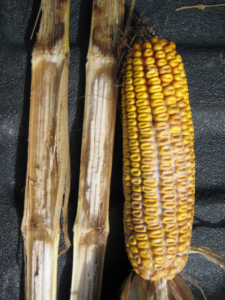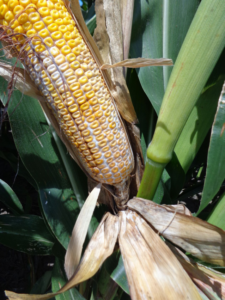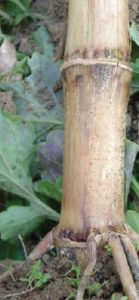- Diplodia stalk and ear rots commonly occur around mid to late ear fill.
- Stalk and ear rots can reduce the quality of the grain and compromise stalk integrity, leading to lodging, premature plant death, and potential yield losses.
- In-season management options are limited but proactive management strategies, such as product selection, reducing inoculum in the field, and minimizing stress, can reduce the incidence of disease next season.
The Diplodia stalk and ear rot fungus overwinters in corn debris; therefore, corn-on-corn fields managed with reduced tillage have an increased potential for Diplodia stalk and ear rots. Diplodia stalk rot commonly occurs around mid- to late ear fill and is favored by late-season stresses such as moisture and nutrient problems, excessively cloudy weather, and invasive injury to the leaves, stalks, or roots.
Diplodia ear rot is favored by dry conditions during the early vegetative growth stages followed by warm, wet weather within the first 21 days after silking. Ear rot can be particularly problematic when rainfall is above average from silking to harvest, or when insects or birds damage the ear during development. Corn products vary in their level of susceptibility to Diplodia; however, any product can be infected under favorable conditions.
Symptoms of Diplodia Stalk Rot:
- Straw-brown discoloration of the lower nodes.
- Internal disintegration of the pith, only vascular tissues remain intact (Figure 1).
- Squishy stalks that break easily. • Small black dots (fungal spore-producing structures) around the lower nodes of infected stalks (Figure 3).

Figure 1. Diplodia-infected ear and stalk.
Symptoms of Diplodia Ear Rot
- Tan or bleached appearance on ears at the base of the husk (Figure 2).
- White to gray mold between the kernels beginning at the base of the ear and progressing toward the tip (Figures 1 and 2).
- Small, black spore-producing structures can be found on the husks, cobs, and kernels.
- If left in the field, particularly when weather is rainy and humid, ears with light infections may become completely mummified by the fungus.

Figure 2. Diplodia ear rot can caused bleached husks and a white to gray mold that begins at the base of the ear and progresses towards the tip.

Figure 3. Fungal spore producing structures.
Yield Impacts
- Lodging.
- Premature plant death.
- Reduced kernel size, grain weight, and nutritional value.
- Lightweight ears subject to breakage and losses during harvest.
- Diplodia does not produce a mycotoxin harmful to livestock, but will result in lower quality feed.
Management
Scouting – Scout for stalk rots as corn reaches the dough through dent stage. Pay close attention to fields with heavy infestations of leaf diseases as these fields may be more prone to stalk lodging later in the season.
To evaluate stalk quality:
- Conduct the push or pinch test by pushing each stalk to approximately a 45-degree angle to see if it breaks or by pinching the lower internodes between your thumb and finger to see if the stalk collapses.
- Conduct either test on 10 plants in a row at several locations throughout the field.
- If stalk quality has been compromised in more than 10% of stalks, then the field should be slated for early harvest.(1)
Management – In-season options for managing Diplodia are limited and fungicides are not effective at controlling the disease, but proactive practices can help manage both Diplodia stalk rot and ear rot in future crops.
- Plant products with good standability ratings.
- Rotate to crops other than corn for 1-2 years.
- Use tillage to bury infected corn residue.
- Protect stalk integrity by controlling foliar diseases and by minimizing nutrient and moisture stress.
- Protect plants from insect damage.
- Plant products with different relative maturities and/or different GDU requirements to flowering so that the entire crop does not flower during peak environmental conditions for Diplodia ear rot infection.
- Lower planting populations.
Grain Drying and Storage
- Schedule affected fields for early harvest to prevent further spread of ear rot if weather conditions have been favorable or if stalk lodging is a concern.
- Allow corn to dry in the field to 23 to 25%moisture and dry grain to 13 to 14% moisture prior to storage.(2)
- Store grain at cool temperatures between 36 and 44°F after drying.
- Limit storage to cold weather and do not store through the next summer.
- Store diseased grain separate from healthy grain.
- Check grain periodically for temperature, wet spots, and insects.
- Clean bins thoroughly before storing.
